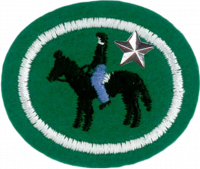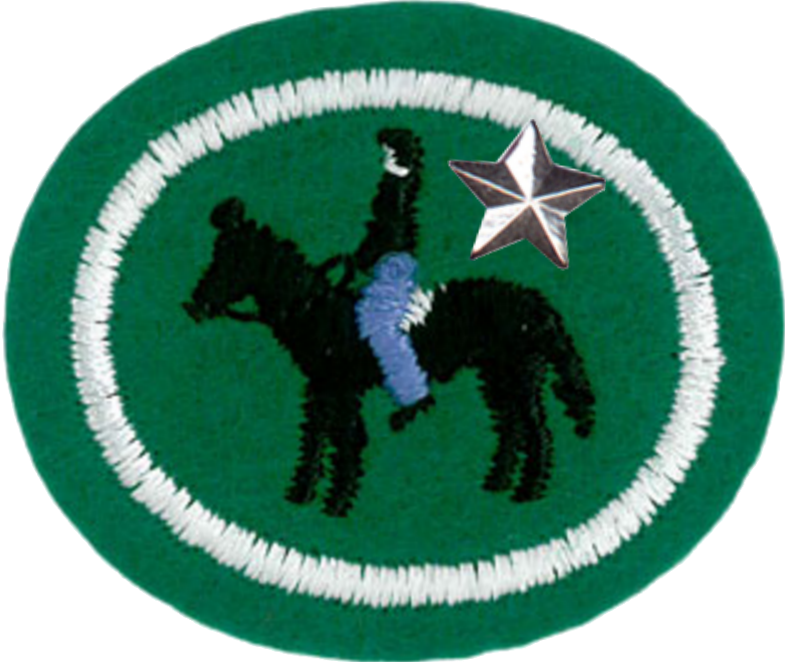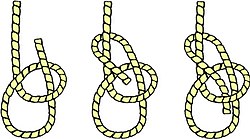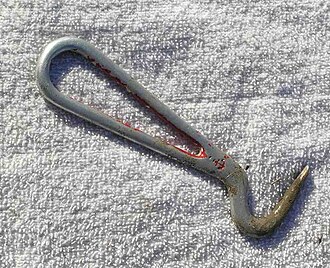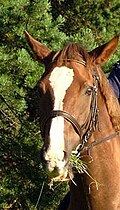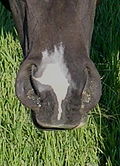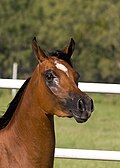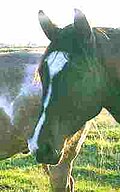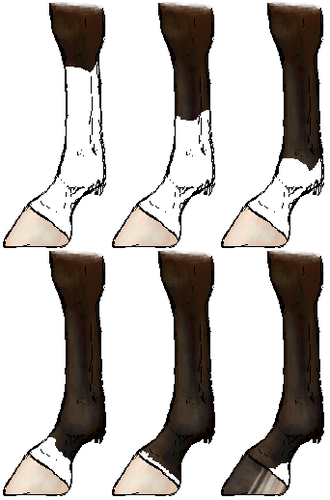Difference between revisions of "AY Honors/Horsemanship - Advanced/Answer Key 2/es"
(Created page with "</noinclude> <!-- 1. Tener la especialidad de Equitación. --> {{honor_prerequisite|honor=Horsemanship|displayname=Equitación}}") |
(Created page with "<noinclude>") |
||
| Line 16: | Line 16: | ||
{{CloseReq}} <!-- 2 --> | {{CloseReq}} <!-- 2 --> | ||
{{ansreq|page={{#titleparts:{{PAGENAME}}|2|1}}|num=3}} | {{ansreq|page={{#titleparts:{{PAGENAME}}|2|1}}|num=3}} | ||
| − | <noinclude> | + | <noinclude></noinclude> |
| − | </noinclude> | + | <!-- 3. Demostrar y explicar cómo cuidar de los aperos (el equipo y accesorios de un caballo). --> |
| − | <!-- 3. | ||
| − | |||
| − | |||
| − | + | {{clear}} | |
| − | |||
| − | |||
| − | + | {{clear}} | |
| − | |||
| − | |||
| − | + | {{clear}} | |
| − | |||
| − | |||
| − | + | {{clear}} | |
| − | |||
| − | |||
| − | + | {{clear}} | |
| − | |||
| − | |||
| − | + | {{clear}} | |
| − | |||
| − | |||
| − | + | <noinclude></noinclude> | |
| − | <noinclude | ||
| − | |||
{{CloseReq}} <!-- 3 --> | {{CloseReq}} <!-- 3 --> | ||
{{ansreq|page={{#titleparts:{{PAGENAME}}|2|1}}|num=4}} | {{ansreq|page={{#titleparts:{{PAGENAME}}|2|1}}|num=4}} | ||
| − | <noinclude> | + | <noinclude></noinclude> |
| − | </noinclude> | + | <!-- 4. Demostrar y explicar la forma de capturar y colocar los amarres al caballo en condiciones seguras. --> |
| − | <!-- 4. | + | <noinclude></noinclude> |
| − | <noinclude | ||
| − | |||
{{CloseReq}} <!-- 4 --> | {{CloseReq}} <!-- 4 --> | ||
{{ansreq|page={{#titleparts:{{PAGENAME}}|2|1}}|num=5}} | {{ansreq|page={{#titleparts:{{PAGENAME}}|2|1}}|num=5}} | ||
| − | <noinclude> | + | <noinclude></noinclude> |
| − | </noinclude> | + | <!-- 5. Demostrar y explicar cómo atar un caballo en condiciones de seguridad con un nudo corredizo y con un nudo as de guía, utilizando la correcta longitud de la cuerda y tratando conforme la altura correcta desde el suelo. --> |
| − | <!-- 5. | ||
| − | |||
| − | + | {{clear}} | |
| − | |||
| − | |||
| − | |||
<div lang="en" dir="ltr" class="mw-content-ltr"> | <div lang="en" dir="ltr" class="mw-content-ltr"> | ||
Revision as of 20:57, 31 October 2022
Nivel de destreza
2
Año
2000
Version
30.12.2025
Autoridad de aprobación
División Norteamericana
1
Para consejos e instrucciones, véase Equitación.
2
3
4
5
Manger Knot
| Manger Knot |
|---|
|
Uso: This knot should be use when tying a horse to a stationary object. Its main advantage is that it can be quickly untied, so if the horse starts to panic it can be quickly freed from the rope before it dangerously tangles itself.
Cómo amarrar:
|
Bowline
| Bowline |
|---|
|
Uso: This knot doesn't jam or slip when tied properly. It can be tied around a person's waist and used to lift him, because the loop will not tighten under load. In sailing, the bowline is used to tie a halyard to a sail head.
Cómo amarrar:
|
6
7
7a
7b
7c
8
9
10
A groom should be especially careful to clean out all crevasses of the hoof, particularly between the frog and the bars, as those areas are most likely to trap rocks or other debris, and also are the most common area to develop thrush. It is best to work the hoof pick from heel to toe, so to avoid accidentally jabbing the horse's leg, the frog of the hoof, or the person using the pick. When picking the feet, the groom stands facing the tail of the horse, then slides his or her hand down the horse's legs. If the horse was not trained to pick up its foot when the groom runs the hand the the fetlock and lifts lightly, most horses will pick up their feet if the tendons behind their cannon bone are squeezed. Some horses, particularly draft breeds, may be trained to pick up their feet when someone pulls on their fetlock hair.
Most horse management guidelines recommend picking the feet daily, and many people pick the feet twice a day, both before and after a ride.
11
12
Horse Colors
Sorrel or Chestnut: A reddish brown horse with reddish, brown or tan mane and tail. Legs are the same color as the body. Their legs may also have white markings. Chestnut runs from very light reddish brown to red or very dark liver color.
Bay: A brown horse with black legs, mane and tail. Body color run from light brown, reddish to very dark brown, but legs, mane and tails are always black (they may also have white markings).
Brown: A very dark brown, almost black coat with lighter brown highlights on the muzzle, the flanks and inside the legs. Mane and tails are always black. They are hard to tell from dark bay.
White: White horses are born white. They have pink skins and usually blue or pink eyes.
Pinto: White plus large patches of black, brown, chestnut or any other colors.
Gray: Born dark with dark skin. Hair becomes whiter with age until pure white. A gray may range from iron gray (nearly black) to dapple gray, white gray or flea-bitten gray (with tiny flecks of black or brown).
Black: Coal black without brown highlights.
Palomino: Golden body color with white mane and tail. Can be a light to very dark gold color.
Face Markings
- Blaze
- A blaze is a broad strip that runs down the horse's face. It does not extend past the eyes, and it is wider than a stripe.
- Stripe
- A stripe is a narrow blaze.
- Snip
- A snip is a marking between the horse's nostrils
- Star
- A star is a marking between the eyes.
- Race
- A race is a crooked or wavy stripe or blaze.
- Baldface
- Baldface is a wide marking on the face that extends past the eyes. Often, a baldface horse will have blue eyes.
Leg Markings
In order of size:
- 1. Stocking
- Stockings extend above the knee or hock and can bleed onto the flank or belly.
- 2. Fetlock or Sock
- White marking that extends over the fetlock, occasionally called a "boot."
- 3. Pastern
- White marking that extends above the top of the hoof, but stops below the fetlock.
- 4. Coronet
- White just above the hoof, around coronary band, usually no more than 1 inch (2.5cm) above the hoof.
- 5. Partial Pastern
- White marking on only one side of pastern.
- 6. Ermine Spots
- Tiny spots of the coat color that show up on a white marking near the coronet band just above the hoof.
- 7. Black Socks or No White Markings
- Some animals have no white on their legs, although some bay animals will have black socks similar to (or in addition to) white ones.
Additional terms used to describe white leg markings include:
- Irregular: A marking within the broad confines of a given height, but with significantly uneven edges. Indicated by the highest point of the white. Most often used to describe certain types of stockings.
- Partial: An irregular marking that only extends up part of the leg to the height indicated, sometimes with the other side of the leg dark. Usually used to describe socks and other short markings.
- "High White:" White stockings that extend above the knee or hock, sometimes extending past the stifle onto the flank or belly, considered characteristic of the sabino color pattern.
13
14
14a
14b
14c
14d
15
16
16a
16b
16c
16d
References
- Kingsmere Crafts - caring for tack.
